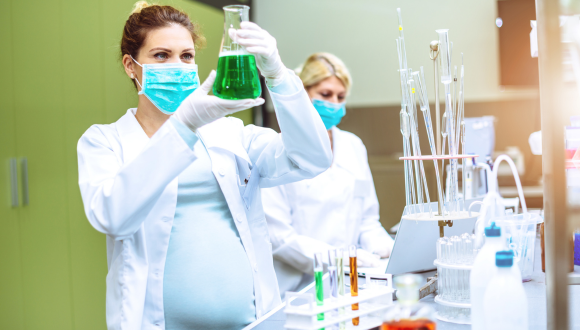Pregnancy in the lab
Laboratory workers are often in contact with various hazardous that can adversely affect reproduction. Since most chemicals have yet to be evaluated for their reproductive effects, laboratory workers who are pregnant, nursing or planning to conceive should consider consulting the Safety officer and the Occupational Medicine doctor
Laboratory Safety
Pregnant women or a person that is planning to conceive should conduct as usually with hygiene practices wearing appropriate personal protective equipment (PPE) and frequent hand washing when working in a laboratory as common laboratory chemical hygiene practices.
Confidentiality
Pregnancy related inquiries are kept confidential. However, if accommodations are necessary for the safety of the unborn child, the supervisor/PI may need to be informed.
Reproductive hazards
Reproductive hazards include substances or agents that can affect reproductive health of women or men, or their ability to have healthy children. These hazards may be chemical, biological or radiological. Exposure can occur through ingestion, injection, inhalation, absorption or radiology exposure. Potential health effects depend on different factors, including the type of hazards, method of exposure, length of exposure, dose received and individual variation (age and stage of pregnancy).
Chemical hazards/Cytotoxic agents
Consult the Safety Data Sheet >> SDS - under section 11- Toxicological information.
Connect to the SDS public medicine library which includes common chemicals used in a Research Molecular Biology Lab. However, many chemicals have not been tested specifically for reproductive toxicity. Treat substances of unknown toxicity and all new compounds as toxic substances.
A brief list of Cytotoxic chemicals can be found at Biosafety as Standard Operating Procedure (SOP). The greatest period of susceptibility to these chemicals is in the first 8-12 weeks of pregnancy, which is a period when a woman may not know she is pregnant. Therefore, always work with these chemicals in a fume hood while using appropriate Personal Protective Equipment (PPE) to avoid exposure.
It is recommended that you contact the Safety staff and/or the Safety Officer at the Faculty of Medicine, Dr. Debi Rapaport if you are pregnant or planning to conceive.
The following list are examples of potential reproductive chemical hazards common in labs.
- Anesthetic gas: nitrous oxide, halothane, isoflurane. Do not work with isoflurane (teratogenic effects)
- Antineoplastic/chemotherapy drugs: consult CDC-Centers for Disease Control and Prevention
- Formaldehyde: formalin, glutaraldehyde. Consult CDC
- Chemical disinfectants and sterilants: glutharaldehyde
- Heavy metals: lead, cadmium, cobalt, mercury
Biological hazards
Standard precautions must be taken to protect against bacteriological/virus hazards. These include wearing appropriate PPE, washing hands, performing routine cleanup of the lab and handling biological waste appropriately.
Viral exposure and viral vectors work consult the Safety Unit
Consult Israel Biological Safety Association (IBSA)
Radiological hazards
Whenever a female isotope/X-ray worker becomes pregnant, she should notify to the Safety officer. Israeli regulations for employing women workers with ionizing radiation is based on international recommendations and standards.
Guidelines for a pregnant women/breastfeeding
- General guidelines as a radioactive worker: to work only in signed radioactive areas and appropriate PPE
- After announcing her pregnancy, the dose to the fetus (external and internal exposure) do not exceed 1 mSv (1 millisievert) during the remaining of the pregnancy period
- Pregnant women will have an additional medical examination in the 4th month of pregnancy (.(page 7
Consult Safety Unit site and Faculty of Medicine Safety Site




